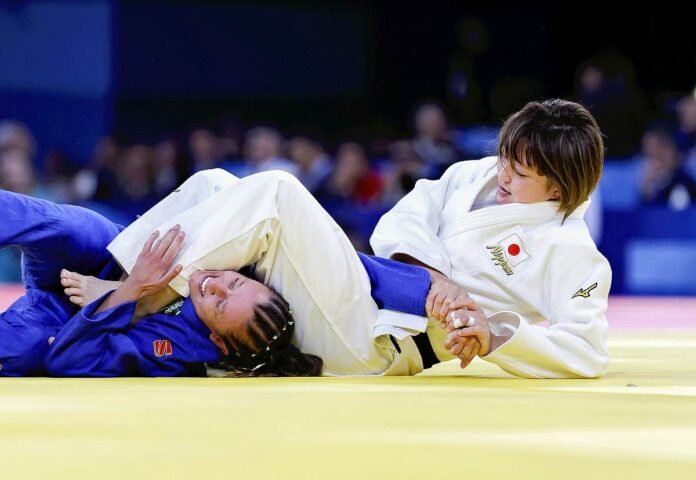Natsumi Tsunoda holds Brazil’s Natasha Ferreira in an armlock during the first round of the women’s 48 kilogram judo class at the Paris Olympics on Saturday.
20:00 JST, July 28, 2024
PARIS — Judoka Natsumi Tsunoda, who won Japan’s first gold medal at the Paris Olympics, is known as a master of kansetsu-waza joint-locking submission techniques. Once she holds her opponent, she never lets go.
Tsunoda, 31, won gold in the women’s 48-kilogram judo division at her first Olympics by making full use of her impeccable techniques that she has been honing since college, and was able to show her strength in her Olympic debut.
Tsunoda walked off the mat after winning the final, hugged her coach and wiped away her tears.
“I fought until the end and just believed in myself,” she said.
When she was in her sophomore year of high school, she was eliminated in the first round of a national competition in 13 seconds. In high school, she never finished higher than third place, so she wanted to quit judo after graduation.
She knew her limits and thought she couldn’t improve anymore.
Because she liked making sweets, she thought she should go to a vocational school to become a pastry chef. At the time, she was offered a place at Tokyo Gakugei University, which had just started building up its judo program. She thought she might as well practice judo while she studied.
Compared to when she was in high school, where she practiced judo almost every day, at university she had two days off a week. The coaches respected the independence of the athletes and gave them the freedom to determine their own training programs.
“I enjoyed talking to others about how to become stronger,” Tsunoda said.
The Chiba Prefecture native reached a turning point in her athletic career when she was invited to join a jiu-jitsu martial arts school after entering university, thinking it would help her improve her judo techniques.
She practiced her ne-waza ground techniques with men weighing over 70 kilograms for over an hour without a break. Once she was so focused that she rendered a man unconscious with a shime-waza choke.
At that time she was working on the development of the ude-hishigi-juji-gatame arm lock technique, in which she clamps an opponent’s arm between her thighs. She studied different ways to execute the technique, depending on the opponent’s body and arm position.
Eventually, she was able to perform the technique smoothly in competitions and became Japan’s No. 1 judoka among university students in her third year. In the finals of the national competition, she defeated her opponent with an armlock for an ippon victory, and soon people began calling her “Kansetsu-waza master.”
Another technique she uses often is the tomoe-nage overhead throw, which she learned after she started working at a company. Once she is back on the mat, she pulls her opponent closer and throws him over her head with her leg. The advantage of this technique is that if she is unable to throw her opponent, she can use ground techniques and transition to a joint-locking submission technique. It is through the use of these techniques that she created her confident style.
Uta Abe, 24, another Japanese judoka who previously fought Tsunoda, said: “She radiated an ominous energy, something I’ve never felt from anyone before. I feel like I’m being played when I enter her territory. Her judo style is like a snake.”
Tsunoda has won three consecutive world judo titles since 2021, showing her overwhelming strength by winning all 15 of her matches by ippon. She won most of her matches with just those two techniques.
She used to worry about criticism from others who said she could only do ground techniques, but she stuck to what she thought was right for her.
“I have overcome my concerns by getting results,” she said.
Before the Olympic final, Tsunoda said: “I created my own judo style. I am happy that I achieved results and kept fighting without giving up.”
And because she believed in herself and stuck to her own judo style, she was able to stand on top of the podium with a gold medal around her neck.



